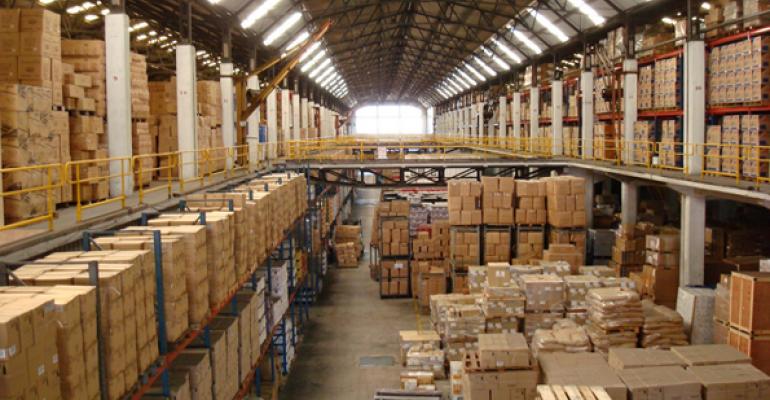Industrial sales in 2017 are expected to exceed 2016 totals, and are estimated to be at the second highest volume since 2007. Sales so far this year total $24 billion, with 245 million sq. ft. of industrial space trading hands, according to John Huguenard, international director of industrial capital markets Americas with real estate services firm JLL. In May, the most recent month for which data is available, sales of industrial properties rose 23 percent year-over-year, to $5.2 billion, according to Real Capital Analytics (RCA), a New York City-based research firm.
U.S. industrial sales peaked in 2015, but sales velocity has remained robust through 2016, when $47.8 billion in industrial properties were sold.
Single-asset transactions drove sales velocity last year, but Huguenard notes that the market has shifted back toward large portfolio deals. The most recent example of this is Canadian investment firm Ivanhoe Cambridge completing an acquisition of Evergreen Industrial Properties, a U.S. owner of light industrial properties, from TPG Properties. (The transaction price has not been disclosed).
Many investors complain about the lack of product to buy, and Huguenard concurs that there are fewer opportunities for smaller investors in the marketplace today. “But as long as there are buyers, those investing can find sellers,” he says, citing recent deals.
Three Boston-based industrial portfolio owners recently sold out, including Cabot Properties, Inc., which sold its 19.8-million-sq.-ft. portfolio to New York City-based DRA Advisors LLC for $1.07 billion; High Street Realty Co., which sold a 6-million-sq.-ft. portfolio to Blackstone Real Estate Income Trust for $402 million; and TA Realty, which sold a 45-property, 8.6-million-sq.-ft. office/industrial portfolio to the Brookfield Premier Real Estate Partners fund for $845.5 million. Approximately 7.5 million sq. ft. in the TA Realty portfolio was industrial product.
Attracted by record rent growth, foreign investors continue to snap up large U.S. industrial portfolios, Huguenard says. Most recently, China Life Insurance Group paid $950 million for a 95 percent stake in a 48-property, 5.5-million-sq.-ft. portfolio of small-market industrial facilities across the U.S., which was sold by Elmtree Funds LLC.
According to JLL’s first quarter 2017 Industrial Outlook report, the U.S. industrial sector has experienced six consecutive years of rent growth. Rent growth has exceeded 10 percent annually in the top four U.S. markets, including Northern New Jersey, South Florida, Seattle and the Inland Empire. Meanwhile, vacancy simultaneously hit new lows. Cap rates have dropped to 4-4.5 percent in these markets. The average cap rate on sales of industrial properties nationwide was 6.8 percent in May, according to RCA. That was in line with average industrial cap rates in 2016 and the average cap rate at the peak of the market in 2007. For most of the past decade, industrial cap rates averaged in the 7.1-8.3 percent range.
“Properties are getting pricey, and people keep saying cap rates can’t go any lower, but that’s been proven wrong,” says Huguenard. The average class-A cap rate across all U.S. primary markets was 4.7 percent in the second quarter of 2017, according to JLL. Investors are willing to pay higher values because they’re making good returns. “I’ve been in this business for 25 years, and for the first time in my career industrial is the most favored property type globally,” Huguenard says.
Part of the favorable outlook for the industrial sector can be attributed to developers of speculative projects exercising more restraint this time around than they did in the last real estate cycle. Product deliveries over the last five years have fallen short of increasing demand for space. Last year, 225 million sq. ft. of new space was delivered, and about 260 million sq. ft. was absorbed. Estimates for 2017 say that 250 to 260 million sq. ft. of industrial space will be delivered, and users are expected to absorb about 300 million sq. ft.
Increasing demand for instant delivery services by e-commerce consumers has also generated a need for smaller distribution facilities in dense, urban locations, according to a first quarter 2017 CBRE report from CBRE.
As a result, developers are focusing on infill sites in highly populated intercity markets, including Chicago, New York, Miami, Seattle and Los Angeles, to build new distribution facilities to serve last-mile e-commerce users, or are buying old buildings and replacing them with new product.
Increasing demand for last-mile distribution space has opened the door to a whole investment area, Huguenard says, noting that buyer competition for urban industrial properties is lifting values for class-B industrial assets.

